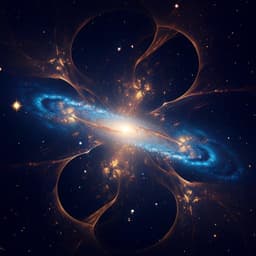
Space Sciences
Imaging low-mass planets within the habitable zone of α Centauri
K. Wagner, A. Boehle, et al.
Exciting new research led by K. Wagner and a team of experts reveals a groundbreaking ground-based mid-infrared observing approach that allows for imaging low-mass temperate exoplanets. This innovative technique has shown remarkable sensitivity to warm sub-Neptune-sized planets in the habitable zone of α Centauri A, setting a new standard in exoplanet imaging.
Playback language: English
Introduction
The search for Earth-like exoplanets is a primary goal of modern astronomy. These planets provide crucial context for understanding our own planet and serve as targets for the search for extraterrestrial life. While giant exoplanets on wide orbits have been directly imaged, enabling studies of their atmospheres and orbits, imaging potentially habitable, lower-mass planets in the habitable zones of nearby stars remains a significant challenge. This challenge is due to the faintness of these planets compared to their host stars, particularly at shorter wavelengths. The habitable zone is defined as the region around a star where a planet with an Earth-like atmosphere could potentially support liquid water on its surface. The α Centauri system, being the closest stellar system to our own, presents an ideal target for such imaging efforts due to its proximity and the Sun-like nature of its primary components, α Centauri A and B. The habitable zones of these stars are at separations of roughly one astronomical unit (au), corresponding to angular separations of about one arcsecond at the system's distance of 1.3 parsecs (pc). This separation is resolvable with existing 8-meter class telescopes. Although current radial velocity measurements exclude planets more massive than 53 Earth masses in α Centauri A's habitable zone and 8.4 Earth masses in α Centauri B's habitable zone, lower-mass planets could still exist and be dynamically stable. Conventional exoplanet imaging, typically conducted at wavelengths of 5 µm or less, suffers from lower sensitivity to temperate planets, which emit most strongly in the mid-infrared (10-20 µm). Mid-infrared imaging, while offering the potential for increased sensitivity, presents challenges due to the significantly higher thermal background and coarser spatial resolution compared to shorter wavelengths. The NEAR (New Earths in the α Centauri Region) experiment aims to address these challenges and demonstrate the feasibility of directly imaging low-mass, habitable-zone exoplanets using ground-based mid-infrared observations.
Literature Review
Numerous studies have focused on direct imaging of exoplanets, with a significant portion concentrating on giant exoplanets orbiting young stars. These studies, employing techniques such as angular differential imaging (ADI) and other advanced high-contrast imaging techniques, have achieved remarkable results in detecting and characterizing these massive, often hot, planets at wide orbital separations (e.g., Marois et al., 2008; Lagrange et al., 2010; Bowler, 2016). However, the focus is shifting towards lower-mass planets located within the habitable zones of their host stars, which are far more challenging to detect. Research is ongoing to improve the sensitivity of imaging techniques to reach the required contrast levels to image Earth-like planets (e.g., Quanz et al., 2015; LUVOIR Team, 2019; Gaudi et al., 2020). Several studies have explored the detectability of planets within the α Centauri system, both considering the dynamics of such systems (Quarles & Lissauer, 2018) and assessing the likelihood of detection with current and planned telescopes (Zhao et al., 2018; Belikov et al., 2019; Gratton et al., 2020; Hunziker et al., 2020). These studies often incorporate sophisticated modeling to account for factors like stellar properties, planetary characteristics, and observing conditions. The challenge of detecting exozodiacal dust, which can mimic the signature of planets, is also highlighted in studies like Beichman et al (2020).
Methodology
The NEAR experiment utilized the Very Large Telescope (VLT) with its VISIR (VLT Imager and Spectrometer for the Mid-IR) instrument, significantly upgraded for this campaign. Key upgrades included a mid-infrared optimized annular groove phase mask (AGPM) coronagraph and a shaped-pupil mask to suppress starlight. The VLT's deformable secondary mirror (DSM) was crucial; it enabled adaptive optics (AO) correction without introducing additional thermal emission from non-cryogenic optics. The DSM was also used to implement a chopping technique, alternating the position of the binary star behind the coronagraph at ~10 Hz to further reduce background noise. Subtracting images taken at alternate positions removed much of the background, including contributions from the AGPM. This strategy ensured that planets orbiting either α Centauri A or B would appear centered on the coronagraph, with planets around α Centauri A appearing as positive point sources and those around α Centauri B appearing as negative point sources. α Centauri was observed for approximately 100 hours, with ~23 hours excluded due to poor observing conditions. The remaining data were processed using two independent pipelines. The primary pipeline involved chop subtraction, co-addition of image cubes, frame alignment using the unocculted PSF of α Centauri B, and sophisticated artifact subtraction (including detector persistence, optical ghosts). The data were then high-pass filtered and processed using both ADI and KLIP (Karhunen-Loève Image Processing) for PSF subtraction. A noise-weighted combination of images from each night produced the final images. The secondary pipeline followed a similar procedure but without artifact modeling, providing a cross-check for the results. The sensitivity of the data was assessed through simulated point-source injection and retrieval tests, creating model planets at varying brightnesses and locations. A Monte Carlo simulation was employed to estimate completeness – the probability of detecting planets of various sizes and orbital parameters within the surveyed parameter space.
Key Findings
The NEAR campaign achieved a sensitivity that is an order of magnitude greater than previous state-of-the-art exoplanet imaging mass detection limits. Based on 75-80% of the highest quality data from 100 hours of observations, the study demonstrated sensitivity to warm sub-Neptune-sized planets throughout much of the habitable zone of α Centauri A. In regions of the image far from the central star, the sensitivity is background-limited, following a signal-to-noise ratio (SNR) proportional to the square root of the observation time. The achieved sensitivity in these regions is approximately 0.75 mJy in one hour of observation. In contrast-limited regions closer to the star, the study found that simulated planets are identifiable at about an order of magnitude above the background noise, or ~2-3 x 10⁻⁶ contrast relative to α Centauri A. The completeness analysis, considering various planetary radii and orbital parameters, indicated a maximum completeness of ~80% for Jupiter-sized planets and ~85% for slightly larger planets, with a small probability (~1-10%) of detecting a warm, smaller planet (R~3 Earth radii) orbiting α Centauri A. One candidate detection, designated C1, was identified in a relatively clean region of the image. This source has a signal-to-noise ratio of approximately 3 and appears consistent with a giant planet (R = 3-11 Earth radii) at about 1.1 au from α Centauri A, or an exozodiacal disk with a substantial dust mass. While not attributable to known systematic artifacts, the nature of C1 as either a planet, a disk, or an instrumental artifact remains unconfirmed. The study's sensitivity analysis suggests that with future improvements, Earth-like planets could be directly imaged within the α Centauri system.
Discussion
The NEAR experiment successfully demonstrated the feasibility of imaging low-mass, temperate exoplanets in the habitable zones of nearby stars. The achieved sensitivity significantly surpasses previous limits, bringing the direct imaging of potentially habitable planets within reach. The candidate detection C1, while requiring further investigation, highlights the potential for discovering planetary systems around α Centauri. Extrapolation to the capabilities of future extremely large telescopes (ELTs) like the ELT/METIS suggests that direct imaging of Earth-analog planets within a few hours of observation should be achievable. This prediction is based on the scaling of the signal-to-noise ratio with telescope diameter and observation time, and the expectation that contrast-limiting factors will be reduced in future instruments. The potential improvements in detector technology and coronagraphic techniques further enhance the prospects of directly imaging terrestrial planets around nearby stars. The existence of C1, even if ultimately identified as an artifact, underscores the potential for detecting low-mass planetary systems in the near future. The analysis highlights the need for further observations to confirm the nature of C1 and for continued improvements in instrument design and data analysis techniques.
Conclusion
The NEAR campaign successfully demonstrated the feasibility of ground-based mid-infrared imaging for detecting low-mass exoplanets in the habitable zones of nearby stars, achieving sensitivity an order of magnitude greater than previous limits. The detection of a candidate object (C1) requires further investigation to confirm its planetary nature. Future improvements in telescope technology, especially the use of ELTs like the ELT/METIS, and advancements in coronagraphic techniques, will significantly enhance the chances of directly imaging Earth-like planets around α Centauri and other nearby stars. Further observations of C1 are needed to verify its nature.
Limitations
The study was limited by the presence of systematic artifacts, primarily detector persistence and optical ghosts, which reduced the overall image sensitivity and increased the probability of false positives. The limited observing time, while substantial, may not have allowed for the detection of all planets within the habitable zone. Confirmation of the candidate detection C1 requires independent verification through additional observations using different methods. The analysis relied on models of planetary atmospheres and internal heating, which might not perfectly represent the diversity of exoplanet conditions. The study specifically focused on the α Centauri system; direct applicability to other star systems will depend on the specific stellar properties and observing conditions.
Related Publications
Explore these studies to deepen your understanding of the subject.







